Test Results
There is no significant difference in power consumption between the Insane and Extreme power profiles. On the contrary, the difference between the former power profiles and the Performance and Baseline ones is vast. Lastly, the power consumption between the Performance and Baseline profiles is only around 10W.
Contrary to the average power consumption readings, the peak readings have significant differences. As you can see, the i9-13900K peaks at 492W in the Insane profile, while in the Extreme profile, its peak power consumption is close to 432W. The CPU’s peak power consumption is far from the corresponding applied BIOS settings even at the more conservative Performance and Baseline power profiles. Imagine this processor paired with an NVIDIA RTX 4090 with a 600W BIOS. Thankfully, all ATX v3.0 and v3.1 PSUs can handle up to 200% of their max power spikes.
The average CPU temperature between the Insane and Extreme profiles is minimal. The difference between the Performance and Baseline profiles is also small, but the difference between the aforementioned profile pairs is vast.
There are slight differences between the pairs of profiles, but the frequency difference is huge between these profile pairs (Insane/Extreme and Performance/Baseline).
In Cinebench R23, the Insane profile offers the highest performance, as expected, with a notable difference from the rest. The Baseline profile heavily impacts the CPU’s performance, while the Performance profile is almost 10% away from the Insane one and close to 6% away from the Extreme one.
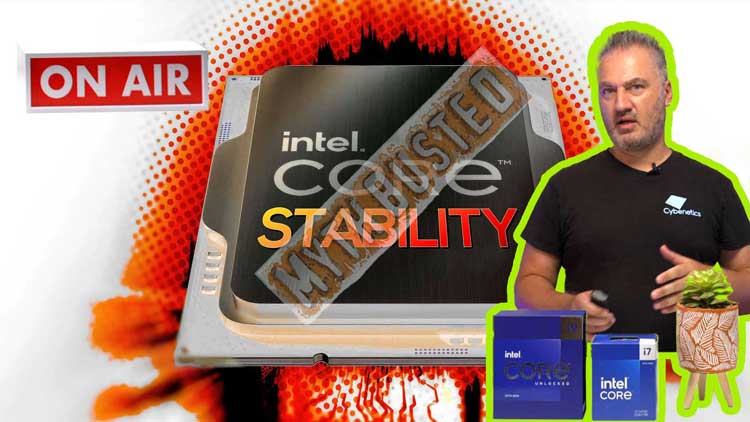
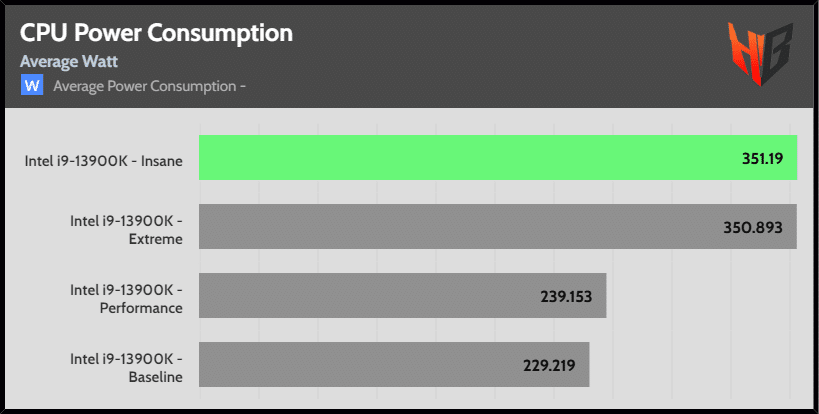


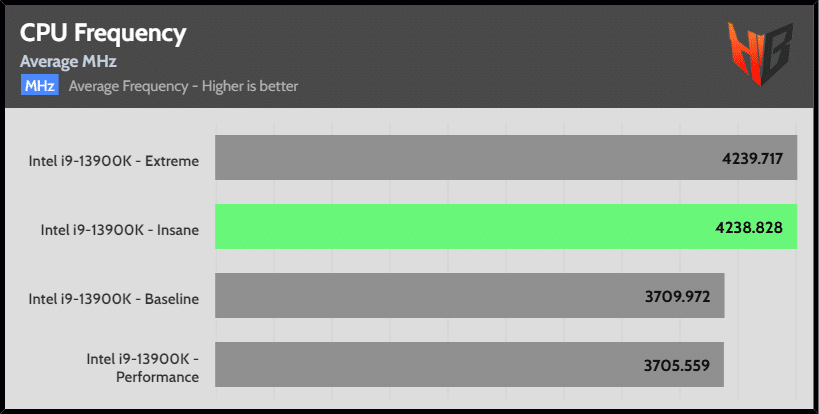
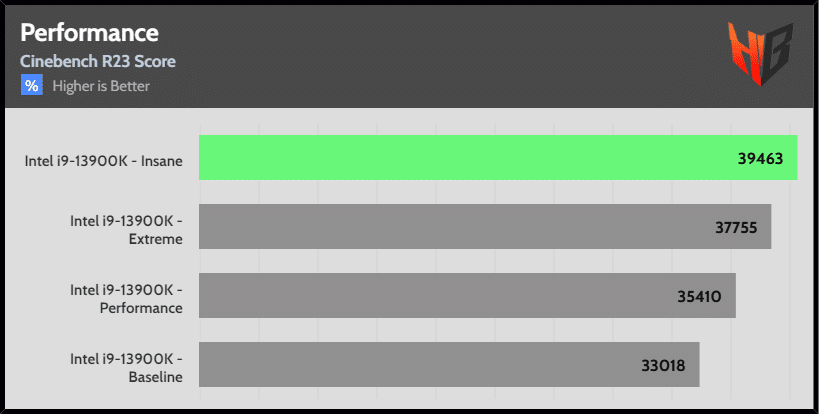
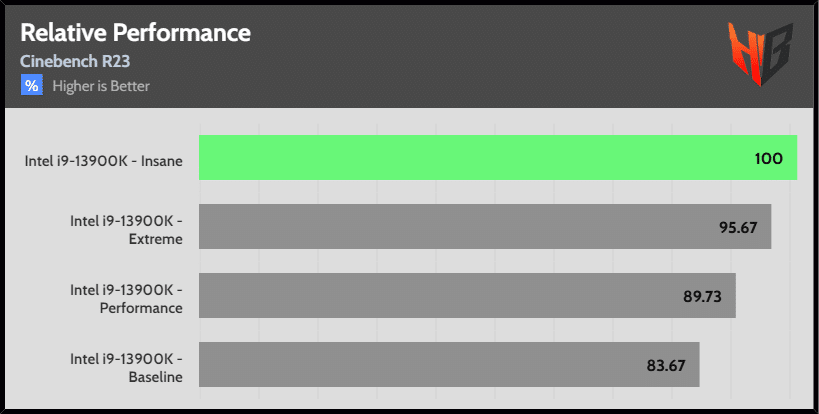
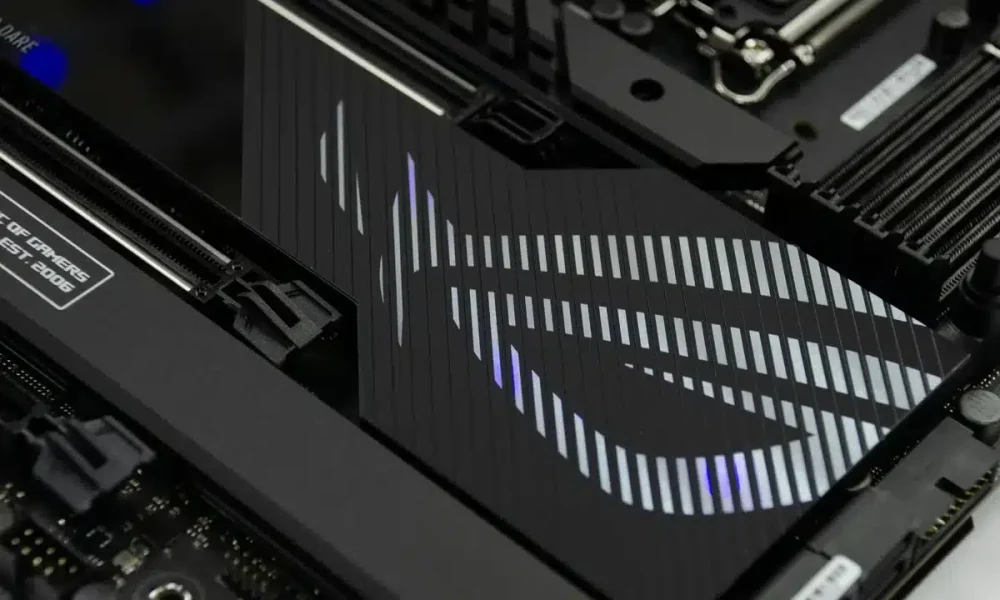
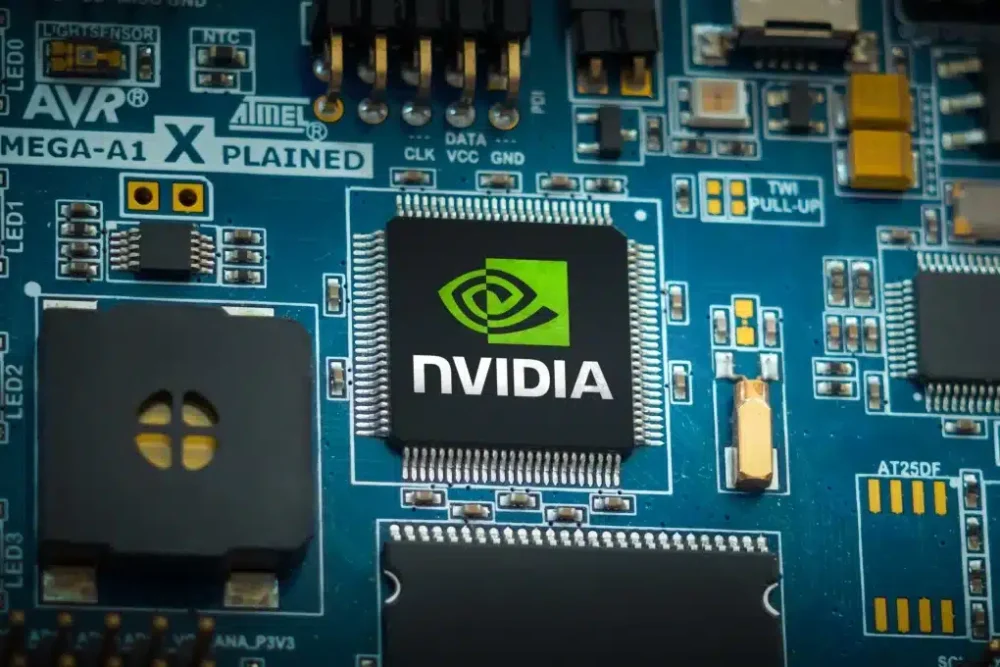
Sorry I am confused. So if I want the best performance for my video editing and gaming. Which is better? Performance or Extreme?
Extreme profile. Or get an AMD Ryzen 7 7950X3D
Thank you. 🙂
The “Insane” setting should at this point be called the “Emporer Palpatine” setting. It’s absolutely fitting. Even after seeing all the talk about the issues people have been dealing with I picked up a 14900k system on a discount that only had a 240mm AIO setup and out of the box it pushed upwards of 6.3 GHz and included loaded ( gaming) temps ranging from high 80’s to 100 and throttling. Also included with that came some similar issues(instabilities) others were having. Our MOBO manufacturers shoving their OC settings down people’s throats is a piss poor business practice. Blaming everyone else (intel) for this is shameful. Intel didn’t set everyone’s bios up. Also, just because I only allow my 14900k to boost to 6.0ghz as advertised instead OC settings pushing it to 6.2+GHz is NOT a loss.of performance. I paid for a chip that runs stable at up to 6.0 and I am now getting what I paid for. Let’s put Emporer Palpatine with his list for power back in his cage and let those who wish to clock up do so at their own risk. Not only the risk of damning their hardware. But at the risk of voiding warranty as well. As it should be. Let’s reel it in people.
> As you will see by my test results, the Baseline profile does hurt performance.
can’t agree with that, it’s true that the performance will be lower than in other profiles but it’s them that increase the performance, not the other way around
and honestly I’d argue that even Baseline profile is a heavy OC since it pushes clocks way above the optimal zone, though limiting that to low thread counts helps reduce the heat output (but dissipating it isn’t easy feat anyway due to the heat density)
unfortunately similar thing happened to Zen 4 lineup, 7950X can pull crazy amounts of heat and nearly incinerate with single core loads, I capped the boost clock a bit on mine and locked U12A at 650RPM (the hearing threshold for me) and sure, it does *only* 90% of the stock CB score but at 150W instead of 230W (so 65%) and it’s still above the optimal clocks for that chip, it can get even more efficient, but I don’t really need that since U12A handles it well (but we’ll see when the summer heat waves hit, it may drop a bit lower then)
–“can’t agree with that, it’s true that the performance will be lower than in other profiles but it’s them that increase the performance, not the other way around…”
…
Well, this is the way the manufacturers choose …it may be not optimal in terms of performance to consumption ratio, but everyone wants to see their product at the top of absolute performance regardless the impacts.
They need the pressure from the consumers/reviewers to change their optics, but the pressure is missing.
as long as it’s the baseline, not eco mode this one should be seen as the base and other profiles as OC
that’s without touching the topic of base being way too hungry already
and I doubt consumers will ever put the pressure, after years of recommending Radeons that provided 15% more performance for 30% higher power draw at the same pricepoint and everyone defending them… we really need legal actions, personally I see two separate issues: efficiency goals and power limit goals, both should be acted upon
there’s no real point of optimizing efficiency of a chip that’s going to pull 300W or more when it’s meant to be a consumer (or end-user, not server) product, optimally all end user hardware should be passively cooled, but top tier active cooling also works for these extreme class products (like flagships), but these coolers really have to be a top class, like my U12A, thanks to extraordinary fans it can handle these 150W without annoying me with noise (and I am *extremely* sensitive to that, I was severely disappointed wit Dark Rock 4 and Ninja 5 on much cooler CPUs), there’s a chance a thicker heatsink paired with T30 would do slightly better, the upcoming D15 successor may also be able to exceed 175W, but I doubt we’ll be able to take care of 200W ranges with aftermarket components
designing the whole machine with that in mind would likely work though
–„…we really need legal actions“
From point of view of the environmental protection and conservation of natural resources it should be a priority…
But!
There must be global consensus about it. If there exist different markets with restricted and unrestricted versions, then the consumer would choose the unrestricted version for themselves.
…
In age (before cca 20 years) of Pentiums, Celerons, and Athlons (one-core CPUs), when overclocking might dramatically change performance, the CPU manufacturers puts a lot of obstacles for overclocking and MB manufacturers raced in terms to make overclocking easier.
…
I think, we can see the winer of this skirmish.
I’d say the OC should be unlocked, if you tolerate noise, huge PSU, overbuilt mobos that’s your choice, but the stock settings should be constrained
for graphic cards though I’m not entirely sure, I’d love to get rid of the power connector completely but that wouldn’t allow for any OC, should people be forced to but pro lineup? maybe, I’d prefer that over being forced to but the pro lineup myself to get a high quality, optimized chip (I already did that once with my A2000, but I don’t want to do that again and to struggle mounting a better cooler on it too)
Why is the “Extreme Profile” in this Test set to 511 A of current? Intel says it should stay at max 400 A and never exceed it.
Also: are the other necessary Settings set correctly (TVB Voltage optimization on, TVB Limit and enhanced TVB Limit on as well as CEP on)?
I guess we would see some more differences between Extreme and Insane if this is all set as Intel wants it to be.
This is the best computer hardware website. It’s a shame that it isn’t widespread. Some other sites have a much larger audience (according to the number of comments, i.e. I can and hope to be wrong), which makes me worry that this project here will no longer be viable for Aris, and he will stop doing reviews. I hope Cybenetics covers the costs.
Hardware Busters is unique. No other website/channel does anything like this.
Yes, it belongs to my holy HW trinity, too (two others are HWCooling (HWC) and TechPiwerUp.com (TPU)).
However, you cannot compere traffic just according to number of comments.
Traffic (1. TPU> 1M/Month, 2. HWB > 4K/Month, 3. HWC > 1K/Month)
Number of comments (1. TPU, 2. HWC, 3. HWB)
Aris has certification approach, and it may reduce number of comments. Moreover, Aris has the aura, he is PhD in the field, the Topmost respected PSU reviewer with long praxis. I believe, if someone want to react to some unclarity, he or she would use the email communication (excluding you 🙂 here and here).
By the way, I hope you appreciate the change.
I do not know, where the second quotation marks at the end of the URL come from (in the HTML code), but could you repair it…
now, the links don’t work.. and delete this post…please.
(for example here: a href=”//www.hwcooling.net/”” <=)
I believe I didn't double them myself, but the redaction system does that.